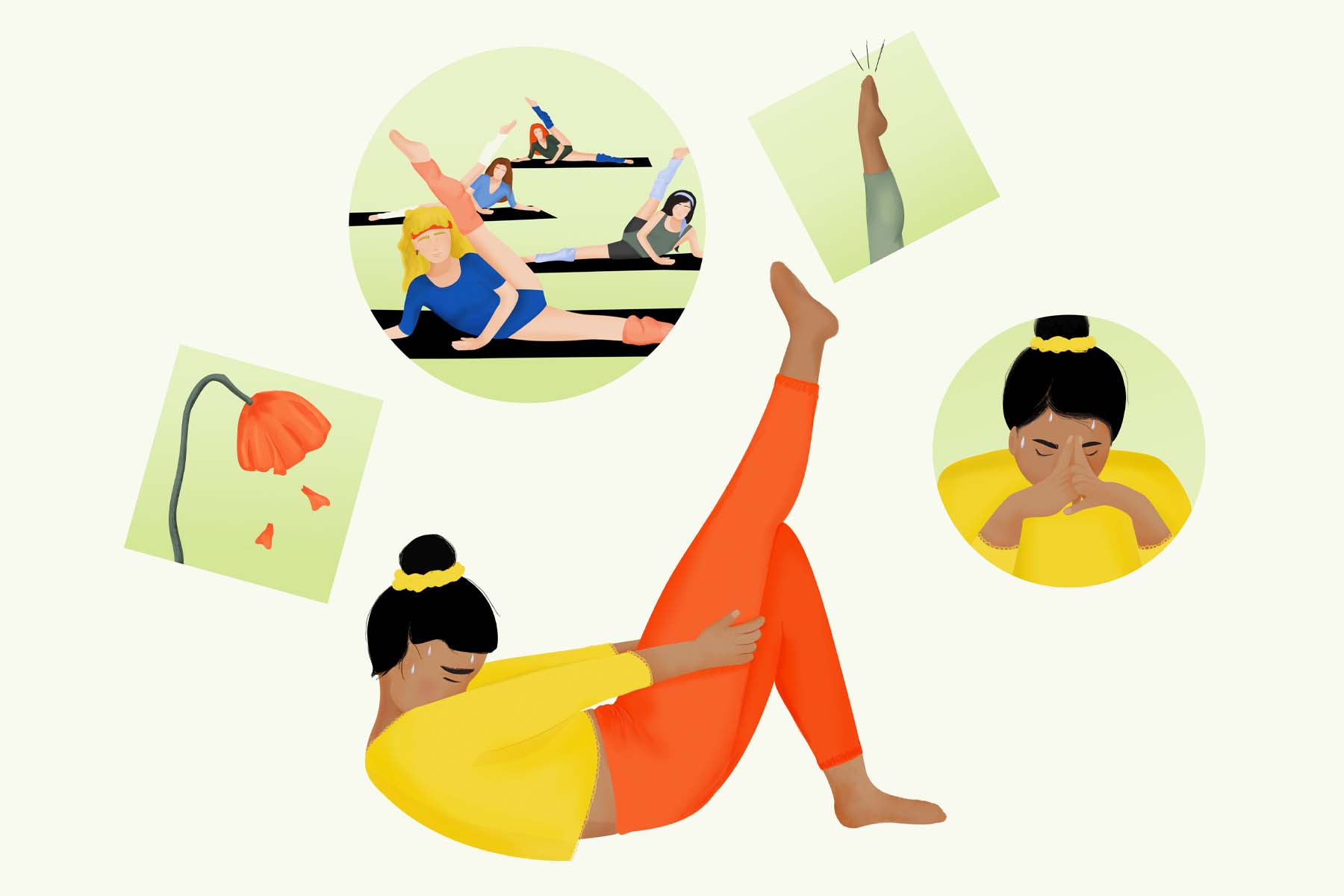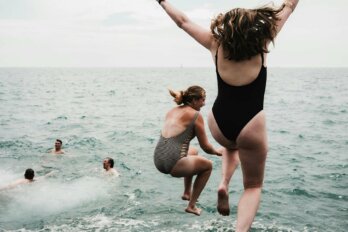Listen to an audio version of this story
For more audio from The Walrus, subscribe to AMI-audio podcasts on iTunes.
About a year into the pandemic, I did something I hadn’t done in years: I searched the depths of YouTube to find a Tony Little Target Training workout video. For the uninitiated, Tony Little, who described himself as “America’s Personal Trainer,” is best known for being a television personality in the ’80s and ’90s. In his many workout videos, which were a staple in my parents’ VHS tape carousel when I was growing up, Little often appeared with big blond hair and shiny Lycra pants, instructing ladies to “squeeze it” with every squat—a measure intended to avoid what he called “droopy buttocks syndrome.” As children, my sister and I spent many mornings mimicking his movements—sit-ups, squats, leg raises—and I fantasized about growing up to look like the model who joined him to demonstrate some of those feats. The fact that she was dirty blonde and white (while I am neither) did not faze me; I was particularly concerned with acquiring her matching floral crop top and bike shorts. (They didn’t appear to sell them in the Cairo neighbourhood where my mom bought many of our outfits.)
As I tried to make it through my first COVID-19 pandemic winter in Toronto, I was desperate to find a way to move my body from its fossilized position at my desk chair. Gyms had been closed for months, and I would have felt uneasy about returning if they had reopened. Walks had gotten icy and dangerous, and I didn’t have the discipline or determination to do unguided workouts like my husband did. Nostalgia seemed like the answer. The pandemic brought with it plenty of television rewatches and reboots, but a quick internet search also suggests that others, like me, gravitated toward workouts of the past. In 2020, the New York Times published a list of vintage workouts to try, including ’80s and ’90s routines starring Cindy Crawford and Alyssa Milano. A New Zealand radio station suggested returning to Cher’s 1992 Hot Dance routine from her famous Cherfitness: Body Confidence video. And viewers of a YouTube clip from the 1998 program Angela Lansbury’s Positive Moves commented to say that they were taking up Lansbury’s gentle stretches for the first time in decades.
New fitness videos also seem to have had a moment. Influencers who post free routines on YouTube have seen a massive surge in their audiences. Australia’s Chloe Ting—who posts flat-stomach and summer-shred challenges—saw her subscriptions jump to 10 million in 2020 and then to 20 million by the following spring. Canadian YouTuber Maddie Lymburner, known as MadFit, quintupled her subscribers to 5 million between 2019 and 2020. After over a decade of fitness being associated with specialized equipment, complicated movements, and memberships to boutique gyms, these videos, which rarely require anything more than a body and a mat, seem refreshing, even liberating. Other data suggests that our return to the workout tapes of old is not just a pandemic blip. Many Canadians say they’re never going back to the gym, and many who do want to return also plan to keep YouTube instructors in their repertoires. According to a 2020 survey by fitness-software company MindBody, 70 percent of respondents who use the company’s app said they had been using prerecorded workout videos since the pandemic started, compared with 17 percent the year before. Nearly 50 percent said they planned to continue.
So, even though I knew I wasn’t the only one doing living room lunges and coffee table tricep dips, I couldn’t help but have mixed feelings. I was excited to be moving my body again, but that excitement came with a sense of discomfort. The videos were fun, but the values they signalled often felt rigid. Was this the best way to get active?
The ways we exercise are often tied up with gender, class, and other social markers. Of course, many people have always enjoyed exercising at home. It’s free or relatively inexpensive, requires little equipment and no travel time, and allows participants to juggle other obligations, like watching kids. Our homes also offer more privacy than most gyms, which have traditionally been unwelcome spaces for LGBTQ2+ customers and women, who often experience harassment. This might explain why some women kept up with their exercise routines when gyms shut down during the pandemic. After all, they have been the targets of home workout videos for decades.
Natalia Mehlman Petrzela is an associate professor at The New School’s Eugene Lang College of Liberal Arts and the author of a forthcoming book on fitness, Fit Nation. She says that technological innovations over the years have inspired—or pressured—people to work out in different ways. A pivotal point came in the 1950s, when television ownership soared across North America and The Jack LaLanne Show, one of the first popular exercise programs of the decade, came to the small screen.
The daytime show sold itself as a break from housework for the decade’s homemakers. For a housewife, a home workout was an opportunity to put down the ironing and have fifteen minutes to herself—a big deal at the time, Mehlman Petrzela reminds me. There was a sense of intimacy too: women could attempt the stretches in the privacy of their own homes, away from prying eyes, without much special equipment, often using a chair, towel, or book. In early episodes, LaLanne, clad in a tightly belted exercise boiler suit complete with shoulder pads and a plunging neckline, became a trainer, cheerleader, and therapist, thanking participants for allowing him into their homes. But the five-day schedule women were encouraged to keep made exercise a sort of labour as well as leisure. The crunches, calf raises, and jumping jacks could easily be perceived as an unavoidable wifely duty, writes Shelly McKenzie, the author of Getting Physical, a 2013 book on the rise of fitness culture in America. In a way, the schedule also advocated a form of self-surveillance, with participants watching for “unwanted” changes in their bodies and chastising themselves for missing workout appointments.
LaLanne’s show was such a hit that it ran into the 1980s, by which time exercise shows had become a broadcast staple. Canada’s 20 Minute Workout, which involved plenty of skin-tight spandex and hair tossing, debuted around this time, featuring a trio of instructors exercising on a rotating platform.
The advent of home video systems and their proliferation in the 1980s and beyond created the next big shift in exercise culture. This was the era of Richard Simmons, with his tiny shorts and encouraging attitude. It was also the era of Jane Fonda’s leg raises in leotards and leg warmers. Now, users—again primarily women—were no longer beholden to a broadcasting schedule. They could exercise whenever they wanted, giving them the ultimate consumer power over their viewing and fitness experience. In particular, Fonda’s tapes set the standard for representing aerobics on video, academics Elizabeth Kagan and Margaret Morse wrote in a 1988 essay titled “The Body Electronic.” The video format “emphasizes repeatability”: it was a one-time investment to be used over and over again. “With the new tool of aerobics,” Kagan and Morse wrote, “rather than masking the devalued aging body one was given by nature, a woman could take the initiative and sculpt her own body toward a new ideal of slender but powerful and curvaceous femininity.”
These messages about the power to control your life dovetail nicely with how we’ve come to think about fitness today, Mehlman Petrzela explains. Much of the same fitness rhetoric from the ’80s and ’90s is still used to market programs today, especially home fitness routines. Kayla Itsines’s wildly popular Bikini Body Guide, better known on Instagram as #BBG and recently renamed High Intensity with Kayla, is a twenty-eight-minute routine that viewers are asked to do three times a week. The implication is that we all have twenty-eight minutes to change our bodies.
Over time, fitness instructors became celebrities. Where, in the past, musicians and actors like Cher or Marisa Tomei used their fame to sell routines designed or even co-instructed by professional, full-time instructors, a new type of celebrity was emerging. Instructors started to be considered celebrities in their own rights. Simmons, for example, made an appearance on General Hospital, and aerobics instructors often showed up on morning talk shows to exercise with the hosts. That trend has continued into today, only intensifying with the pandemic. Peloton, in particular, has emphasized the individuality of each of its instructors down to the music they play during a class. Spin instructor Cody Rigsby, who is known for his fun pop-based routines, competed in the latest season of Dancing with the Stars. It’s entirely possible that this most recent iteration of the fitness celebrity was facilitated by the fact that many people have been glued to their screens for lack of anything better to do, creating a feedback loop of popularity for the people who “got us through” the pandemic, Mehlman Petrzela suggests.
Perhaps this is where my discomfort with workout videos began. Everywhere I turned, it seemed as though the instructors on my screen were (mostly white) women with perfectly parallel ab lines, peppy ponytails, and matching pastel workout sets that lay smooth on their slender bodies. These images in no way mirrored the sheer misery I felt every day, trying to exercise in the room where I’d just shut down my work laptop, had lunch, taken all my breaks, and attended virtual therapy. They certainly didn’t mirror the stretched-out leggings I hadn’t had a chance to replace, the sports bra that had never fit me right, or the glasses that kept sliding down my sweaty nose. Nor did they mirror my anxiety about knocking over a tower of books if my burpees got too energetic or the looming threat of work deadlines. And aspiring to visible abs seemed low on the priority list when I spent every day worrying about family members who are front line workers. (That kind of stress, I know, is amplified greatly for those who can’t work from home like I do, for parents caring for young children, and for many others.)
Kagan and Morse pick up on a similar thread in “The Body Electronic.” In aerobics videos, there is a subtle contract being made with the viewer, they explain. The message is “Do like me and you will be like me.” Mirroring the motions of a superstar every day promises a transformation not just of the body but of the self and the surrounding world. Yet, for me and, I suspect, many others, the juxtaposition of these perfect bodies and their perfect fluid movements with the chaos of the world often seemed like yet another punishment.
Sometimes, it’s not enough for today’s fitness influencers to offer up individual workouts. Instead, they frequently combine multiple routines into a “challenge,” and at no time are these more ubiquitous than in the first few weeks of January. In the lead up to 2022, California-based Pilates instructor Cassey Ho, better known as Blogilates, announced the “best New Year’s challenge in the history of Blogilates new year challenges.” These usually involve a calendar that schedules different routines throughout the month, and their marketing often begins in December, with some variation on the “new year, new you” mantra. Monday: upper body; Tuesday: legs and butt; Wednesday: abs; and so on. This one, Ho promised, would take participants through a “full body, full soul transformation that will cover: fitness, food and feelings.” Other instructors follow similar formats. Chloe Ting runs a two-week “shred,” and Yoga with Adriene has run a thirty-day series every January since 2015. Though instructor Adriene Mishler describes hers as a “journey” rather than a challenge, the intention is still to have the user showing up on the mat every day for a month.
I’ve attempted many such challenges throughout the years. It’s perhaps no surprise that these commitments to exercise and well-being often coincided with the worst periods of my life. After a particularly devastating break up, I repeated the same punishing Pilates video over and over again in my dorm room. In grad school, overwhelmed with work and bills, I began a Blogilates calendar. (It turned out that no amount of headstand training could treat the effects of living in an $800 windowless room in a shared downtown Toronto apartment.) And, the following year, I tried thirty days of yoga after my therapist suggested I engage in more self-care. But, as I watched Mishler twist and bend on her mat, all I could do was be jealous of her ease, her spacious studio, and her charming dog Benji. It’s perhaps even less of a surprise that I never made it past the one-week mark on any of these commitments. The elation of trying something new was always replaced with dread and exhaustion. I almost never made it to the stage psychologists describe as “building mastery”: getting good enough at something to feel confident and in control.
As the pandemic wore on and I began experimenting with home workouts again, the thought of starting such a challenge popped into my mind more times than I can count. Despite all my misgivings about video routines and the challenges that often accompany them, I had an overwhelming desire to find mastery in the chaos, to finish a challenge this time. But perhaps it is exactly this desire that takes away from the joy of exercise. Where I once thought the rigidity of a schedule or the continual repetition of movements was what resulted in a “successful” workout, in the pandemic, I finally found myself embracing the chaos of trying new things. I played tennis (terribly). I ran outside (also terribly) as the temperature dropped. I took outdoor yoga classes. I went on a foraging hike. I even tried a windsurfing lesson. And, when these activities required instructors, I found pleasure in meeting people outside of a video-based setting. Instead of a fitness influencer posing in a professionally lit studio, there was the instructor who scarfed down a chip-truck sandwich before demonstrating how to balance on a windsurfing board or the tennis teacher I recall making a self-deprecating comment after a bad serve—something that would probably have been edited out of a YouTube video.
In some ways, people have had to get more creative with exercise during this time, explains Katie Rose Hejtmanek, an associate professor of anthropology at Brooklyn College who focuses on fitness. That could be because we’ve broken free of the formal rules around what exercise needs to look and feel like. It is precisely this formalization of exercise that has taken some of the pleasure out of physical activity, argues McKenzie in Getting Physical. “The circumscription of exercise as a handful of specialized, non-competitive, individual activities conducted outside of one’s daily routine, usually involving distinctive clothing and footwear . . . has narrowed the way we think about exercise and increased the lengths we believe we have to go to engage in it,” she writes.
Still, Mehlman Petrzela suggests I might be too skeptical. “It’s hard to know if this rise in online fitness culture is contributing to a greater standardization of experience that privileges very particular aesthetics and very particular body types,” she says, “or whether the internet and its endless boundaries are actually doing the opposite.” Sure, there are the conventional fitness influencers, she says, but we’re also getting access to routines by diverse fitness influencers, like Fat Kid Dance Party aerobics, run by certified group fitness instructor Bevin Branlandingham, who identifies as queer, fat, and femme. “There’s no wrong way to do this,” Branlandingham says in a video on aerobics rules. “I’m going to give you movements as options, but I want you to do them how they feel good in your body today. Not the body you had ten years ago, not the body you think you should have, just this body today.”
It’s perhaps this message that I want to hold on to as a new wave of COVID-19 has unsettled my routine once again and as subzero temperatures have put many of my outdoor adventures on pause. I don’t doubt that I’ll return to the Tony Little video once or twice this winter; the nostalgia will still be comforting. But perhaps, this time, I won’t feel as bad about the stretched-out leggings I still haven’t replaced and will instead give myself a little more grace to skip workouts, to lie on the floor when a set feels like too much, and to spend a little less energy trying to control and monitor my body.
Correction February 12, 2022: An earlier version of this article misspelled Natalia Mehlman Petrzela’s last name. The Walrus regrets the error.





